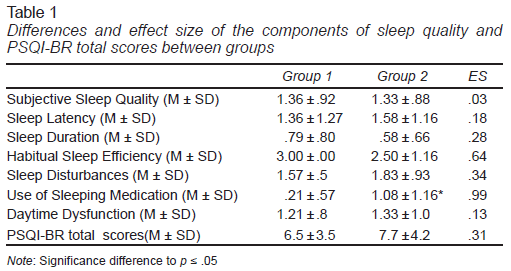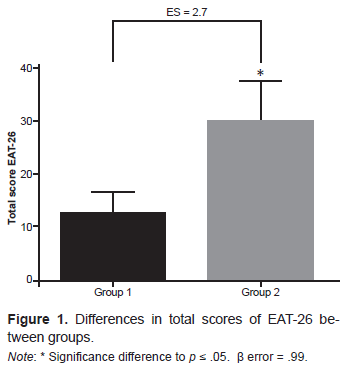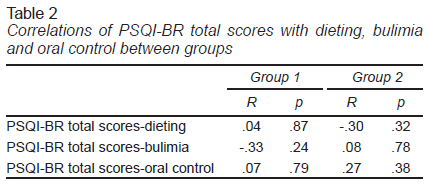INTRODUCTION
Epidemiological data indicate that about 66.73% of Brazilian women have sleep problems (Lucena et al., 2020). Sleep problems, such as insomnia and poor quality of recovery after a nightʼs sleep, appear to be increasingly common in the general population (Manjavong, Limpawattana, Mairiang, & Anutrakulchai, 2016). Previous studies have showed that these sleep disorders have adverse effects on health and physical performance (Swinbourne, Gill, Vaile, & Smart, 2016), which would explain the worsening of sleep quality in athletes in recent years (Sargent, Halson, & Roach, 2014; Swinbourne et al., 2016).
On the other hand, these problems in sleep quality seem to be closely related to some poor activities of daily living, especially activities that modulate negative emotions. The relationship between sleep difficulties and behavior that cause negative emotions are well-documented in the literature (Shen, Van Schie, Ditchburn, Brook, & Bei, 2018; Palmer, Alfano, & Bower, 2019). However, it is not yet known whether risk behaviors for eating disorders can compromise sleep quality, especially in individuals that practice sports.
Eating disorders can be defined as psychiatric disorders linked to eating behaviors and have physiological and psychological effects (Ozier & Henry, 2011). Patients with a clinical diagnosis of eating disorders have behavioral symptoms (restriction of food intake for long periods, self-induced vomiting, binge and purgative behaviors [laxatives/diuretics and excessive exercise]), which are called risk behaviors (Fisher et al., 2014). Approximately 25% of females who practice sports have risk behaviors for eating disorders to regulate/control body mass (Bratland-Sanda & Sundgot-Borgen, 2013), especially individuals who practice combat sports with categories established by body mass (Rouveix, Bouget, Pannafieux, Champely, & Filaire, 2007; Filaire, Rouveix, Pannafieux, & Ferrand, 2007) such as BJJ.
The literature shows that women who practice Judo have higher indicators of eating disorders than men who practice it. (Escobar-Molina, Rodríguez-Ruiz, Gutiérrez-Garcia, & Franchini, 2015; Franchini, Brito, & Artioli, 2012). These disorders are a psychological response to competitive weight-loss strategies, leading to adverse physiological impacts such as self-induced vomiting and diuresis (Escobar-Molina et al., 2015).
The literature points out several findings relating eating disorders with sleep problems (Lauer & Krieg, 2004; Tzischinsky, Tokatly Latzer, Alon, & Latzer, 2021). Abdou et al. (2018) have shown a relationship between these disorders and poor sleep quality in women diagnosed with bulimia and anorexia. This relationship seems to be associated with hormonal, neurological, and behavioral changes (Lauer & Krieg, 2004; Tzischinsky et al., 2021). Thus, female fightersʼ health is negatively affected, and their sports performance is reduced.
However, to the best of the authorsʼ knowledge, the literature does not report the relationship between risk behaviors for eating disorders and sleep quality in women who practice combat sports.
The findings of this investigation may indicate whether a higher frequency of risk behaviors for eating disorders affects the sleep quality in women who practice BJJ. If this relationship is genuine, coaches, and professionals working in combat sports will be ideally able to track women with a high frequency of risk behaviors for eating disorders. Thus they may refer these individuals to cognitive-behavioral therapy in order to improve their sleep quality and recovery, even if indirectly. Therefore, the present study aimed to compare the sleep quality among women who practice BJJ due to risk behaviors in eating disorders. A hypothesis was formulated: females who practice BJJ with a higher frequency of engaging in risk behaviors for eating disorders have a worse sleep quality.
METHOD
Design of the study
This is an observational and cross-sectional study designed to compare and verify the correlation between sleep quality and risk behaviors in eating disorders of women who practice BJJ.
Participants
Twenty-six females who practice BJJ (Mean ± SD = 29.46 ± 7.46 years; 65.12 ± 10.58 Kg; 1.63 ± 7.36 cm; Body Mass Index = 25.44 kg/m2) participated in this study. Volunteers belong to the following belt categories: 11 white belts, eight blue belts, six purple belts, and one black belt. In turn, the weight category had the following distribution: seven rooster, six light feather, six feather, five light, one medium heavy, and one heavy. To participate in the study, women who practice BJJ had to train for at least six months continuously, and not having suffered any injury in the last six months, in addition to training at least twice a week. Volunteers were excluded from the study if they did not answer the instrument items. Participants performed 4.46 ± 2 training sessions per week, and the duration of the training sessions was 85.19 ± 23.6 minutes. The total practice time of BJJ was 48.27 ± 38.19 months. We want to emphasize here that all women are amateur fighters.
Procedure
Women who practice BJJ were invited to participate in the research at the gyms where they regularly trained. After completing the Free and Informed Consent Form, the fighters answered the instruments on their own without any disturbance or interference from third parties.
Measurements
EAT-26. The Eating Attitudes Test (EAT-26) is a psychometric instrument developed by Garner, Olmsted, Bohr, and Garfinkel (1982). It was cross-culturally validated for the Portuguese language in Brazil by Bigheti, Santos, Santos, and Ribeiro (2004). The EAT-26 consists of 26 items with six response options with scores ranging from 0 to 3 (3 = Always, 2 = Usually, 1 = Often, and 0 = Sometimes, Rarely or Never). Only item 25 has an inverted score (0 = Always, Usually or Often, 1 = Sometimes, 2 = Rarely, 3 = Never). All 26 items are subdivided into three subscales: 1. Dieting: focuses on caloric limitation and the concern exacerbated with thinness; 2. Bulimia: considers events of high food intake and pathological methods of controlling body mass, 3. Oral Control: shows how the relationship of self-control with food and eating habits occurs within a socio-environmental context. A score higher than 21 points would already be a risk indicator for the onset of eating disorders. For this study, the internal consistency values in Cronbach α was .80.
Pittsburgh Sleep Quality Index (PSQI). The Pittsburgh Sleep Quality Index was created by Buysse, Reynolds, Monk, Berman, and Kupfer (1989). It was cross-culturally validated for the Portuguese language in Brazil by Bertolazi et al. (2011) PSQI-BR. The instrument consists of 10 items with sub-items, which amount to 19 questions. The test assesses sleep quality and includes the following components: subjective sleep quality, sleep latency, sleep duration, habitual sleep efficiency, sleep disturbances, use of sleeping medication, and daytime dysfunction. The final assessment is based on the score obtained, classifying an individual as a poor sleeper when the score is ≥ 5 points. The PSQI-BR is a subjective measure of sleep that is commonly used to present credibility for research and the clinical field. For this study, the internal consistency values in Cronbach α was .67.
Statistical analysis
The Shapiro-Wilk test was used to analyses data distribution. Mean, standard deviation, and percentages were obtained to characterize the data of the analysed variables. The unpaired t-test was used to compare the mean of the two groups (with and without the prevalence of indicators) and adopted a significance level of p ≤ .05. The Cohen test (Cohen, 1992) was used to analyses effect size (ES) (mean group 1-mean group 2/standard deviation of both groups). The classification of effect size is divided as .2 small, .5 medium, .8 large, and 1.3 very large. Pearsonʼs linear correlation has been used to correlate sleep quality with risk behaviors for eating disorders.
Ethical considerations
All participants signed a Free and Informed Consent Form and were aware of all aspects of the research. The research protocol was approved by the ethics committee of the State University Vale do Acaraú, with protocol number 3.095.508.
RESULTS
From the 26 women who practice BJJ who participated in the study, 14 fighters (53.8%) had scores equal to or lower than 21 points (Group 1 - no prevalence), and 12 fighters (46.2%) had scores above 21 points in the EAT-26 (Group 2 - prevalence).
When analyzing the components of the sleep quality index by group (Table 1), only the component “use of sleeping medication had a statistical significanc” (t = -2.4; df = 16; p = .02; β error = .79) and a large effect size (ES = .99) when comparing groups 1 and 2.
However, there were no differences between groups when comparing PSQI-BR. It should be emphasized that, regardless of whether there were any differences, both groups had poor sleep quality considering the value above five points, as described in the method section.
When analyzing the results of the EAT-26 instrument, differences in total scores should be highlighted (Figure 1) because they are statistically significant, and the effect size was very large, which shows a fundamental difference between the groups.
There were statistical differences for the components Dieting (Group 1 = 6.7 ± 3.6 and Group 2 = 15.7 ± 5.3/ t = -5.1; df = 19; p < .001; β error = .99; ES = 1.9) and Bulimia (Group 1 = 3.9 ± 2 e Group 2 = 10.9 ± 3.7/ t = -6; df = 16; p < .001; β error = .99; ES = 2.3). There was no difference in the component Oral Control (Group 1 = 1.9 ± 2 and Group 2 = 2.5 ± 2.7/ t = -.61; df = 20; p = .54; β error = .15; ES = .25).
When analyzing the data resulting from Pearsonʼs correlation, we found no correlation between EAT-26 total score – PSQI-BR total score in group 1 (R = -.077 and p = .79) and group 2 (R = -.011 and p = .97). Finally, there was no correlation between the PSQI-BR total scores and the EAT-26 subscales, as shown in Table 2.
DISCUSSION AND CONCLUSION
The study aims to compare the differences between eating disorders indicators with sleep quality and possible correlations.
In the case of this study, the prevalence of eating disorders indicators in group 2 (n = 12) is 46.2%, which is above the population prevalence that ranges between 2.8% to 4.6% (Hay, 2020). The literature suggests that athletes should be treated differently from the general population, as some more complex specificities such as eating behavior, mental health aspects, and training routine must be considered (Stranberg, Slager, Spital, Coia, & Quatromoni, 2020).
Both groups had scores of sleep quality that classify them as poor sleepers (PSQI-BR scores higher than 5), but with no statistical difference between both groups. One factor contributing to these high rates of poor sleep quality is the modern lifestyle (Farhud, 2015), mainly due to excessive electronic devices use at bedtime (Tähkämö, Partonen, & Pesonen, 2019). On the other hand, poor sleep quality seems to influence negatively the physical (McMahon et al., 2019), mental aspects (Montagni, Qchiqach, Pereira, Tully, & Tzourio, 2020), and the quality of life (Lee, Kim, & Chung, 2021) of the general population. However, although poor quality and sleep disorders are associated with increased indicators in people eating disorders (Linnaranta et al., 2020), no difference in sleep quality was found between the groups.
It is worth mentioning that, although both groups are considered as poor sleepers, some of the fighters had good sleep quality based on the standard deviation of the mean. These findings are corroborated in a study with male who practice BJJ, who showed a similar pattern in sleep quality within the groups (Vieira, Mouta, Solon Júnior, & da Silva Neto, 2021).
Specifically, in sport, poor sleepers have negative impacts on several biological conditions such as increased pain perception, episodes of illness, and several injuries (Biggins, Cahalan, Comysns, Purtill, & OʼSullivan, 2018; Simpson, Gibbs, & Matheson, 2017) that affect both aspects of health and performance. It should be noted that the literature does not offer robust evidence on these aspects related to sleep quality, specifically in womenathletes, let alone in womenfighters.
Two components that showed statistically significant differences were dieting and bulimia, considering that they are both directly linked with a strategy to qualify for specific weight categories in the martial arts (Franchini et al., 2012). It is possible that dieting and bulimia can cause harm as menstrual and psychological dysfunctions (Rouveix et al., 2007). Also, the literature presents data showing a relationship between eating disorders and sleep quality as a result of similar brain regions and neuropeptides regulating the processes of eating and sleeping (Abdou et al., 2018).
Our results showed that consumption of sleeping medication was higher in group 2, which has higher scores for indicators of eating disorders. According to the literature, women with higher indicators for eating disorders or even a clinical diagnosis of Bulimia and Anorexia tend to consume more licit and illicit drugs (Piran & Gadalla, 2007;Killeen, Brewerton, Campbell, Cohen, & Hien, 2015) and medications (Bulik, 1992), which justifies the higher consumption of sleeping medication in group 2.
In conclusion, the prevalence of eating disorders indicators is high in women who practice BJJ, as groups with no prevalence (Group 1) and with prevalence for indicators (Group 2). Both groups have poor sleep quality, being classified as poor sleepers; it should be noted that group 2 consumes more sleeping medication than group 1. However, when correlating the eating disorders indicators and the subscales with sleep quality, there is no data to indicate the existence of any relationship.


